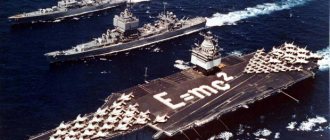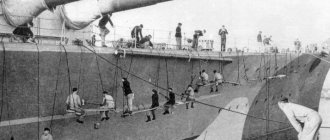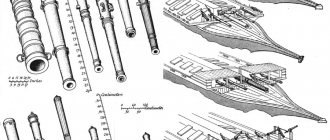Aircraft-carrying cruiser "Kyiv"
| Aircraft-carrying cruiser "Kyiv", theme park | Aircraft-carrying cruiser "Kyiv" | Project 1143 heavy aircraft-carrying cruiser |
The heavy aircraft-carrying cruiser (TAKR) "Kyiv" was the lead ship in a series of two ships of Project 1143 (code "Krechet"), which was built for the USSR Navy. He was part of the Northern Fleet of the USSR Navy (USSR Navy; Severomorsk). The second ship was the Minsk TAKR, which was decommissioned on June 30, 1993.
Until June 28, 1977, they were classified as anti-submarine cruisers.
The Kiev aircraft carrier was laid down on July 21, 1970 (building number 101) in Nikolaev at the Black Sea Shipyard. Launched on December 26, 1972. Construction was completed on December 28, 1975.
In July-August 1976, the Kiev aircraft carrier with five combat Yak-Z6M and one training Yak-Z6MU made the transition to its home base in the Northern Fleet. The first Yak-Z6M flights outside the USSR took place in the Mediterranean Sea. In the North, in August-December 1976, state tests of the second stage were carried out - the Basalt strike missile system, comprehensive tests of electronic weapons as part of a ship group, group flights of LAC, as well as seaworthiness tests of the ship. By government decree in February 1977, the Kyiv aircraft carrier was adopted by the Navy. Had the following tail numbers: 852 (1975), 860 (1976), 812 (1977), 802 (1978), 060, 062 (1978), 121 (1982), 069 (1983), 051 (1985), 075 (1988).
Main characteristics: Full displacement 30530 tons, standard displacement 41370 tons. Length 273.1 meters, beam along the vertical line 31 meters, flight deck width 49.2 meters, draft 8.95 meters. Speed 32 knots. Installed power 182500 hp. (134225 kW). Cruising range 8000 miles at 18 knots. Autonomy 30 days. Crew: 1433 people, including 280 officers and 276 midshipmen, plus 430 air wing people.
Weapons:
Missile armament: 4 × 2 launchers of the P-500 “Basalt” anti-ship missile system.
Aviation group:
Air squadron: 18 aircraft (vertical take-off and landing), 18 helicopters.
The boat has a hangar measuring 130 x 22.5 x 6.6 meters.
In 1977-1982, "Kyiv" repeatedly carried out military service in the Atlantic and the Mediterranean Sea. By the end of 1977, 34 naval pilots were already flying in the 1st naval assault aviation regiment, which formed the TAKR “Kyiv” air group. During the voyage from December 15, 1978 to March 28, 1979, 355 flights were performed from the ship on Yak-38 aircraft. In 1982-1984, the TAKR underwent a medium overhaul at ChSZ. While on a visit to Algeria in May 1985, its crew learned that the ship had been awarded the Order of the Red Banner for success in combat training. Long-distance voyages of "Kyiv" continued until the end of 1991. When the Black Sea Fleet was divided, the USSR went to Ukraine.
In 1993, due to a lack of funds for operation and repair, significant depletion of weapons, mechanisms and equipment, it was withdrawn from the Ukrainian fleet, then disarmed and sold to the PRC government. On May 17, 2000, the ship was towed from the Vidyaevo naval base, Russia to the port of Tianjin, China, where it was converted, as was officially announced, into a museum, but in fact into an amusement attraction. In September 2003, the Kiev was towed to Tianjin, where it is part of a theme park.
In 2011, the aircraft carrier Kiev was completely converted into a luxury hotel with 148 rooms of various categories, including presidential class, for which about $15 million was spent. The sailors' cabins were converted into rooms for guests. There are also restaurants on the former aircraft carrier.
On the outside, the aircraft carrier has changed little - old weapons flaunt on the deck, so the Kiev performs two functions at once in Binhai Park - it complements the exhibition as an example of military equipment of the USSR and welcomes guests like an original hotel.
In 2014, the park complex, created on the basis of the decommissioned Soviet aircraft carrier Kiev, was visited by 1.4 million people, which set a new record.
Notes and links[edit]
- ^ abcde "Heavy aircraft-carrying cruisers - Project 1143". russian-ships.info
. 2013. archive from the original on October 29, 2014. Retrieved December 6, 2013. - Due to restrictions imposed by the Montreux Convention limiting the tonnage of aircraft carriers sailing through the Bosporus, all Soviet and Russian aircraft carriers are called aircraft-carrying cruisers. In the case of Kiev
, this accurately reflects the purpose of the ship and the placement of weapons. - ^ ab Holm, Michael (2013). "Kyiv-class". ww2.dk.
_ Retrieved December 6, 2013. - Leisure Quest International - About the company
- Branigan, Tania (August 10, 2011). "China launches second aircraft carrier - like a luxury hotel". The keeper
. Retrieved December 6, 2013.
- Zablotsky, V.P. (V.P. Zablotsky) (July 2003). "Heavy aircraft-carrying cruiser "Kyiv"" [Heavy aircraft-carrying cruiser "Kyiv"]. Marine Collection ("Maritime Collection")
.
New Generation
On the basis of Project 1123, the development of a new ship began - a well-armed anti-submarine cruiser, which was supposed to use airplanes rather than helicopters as an aviation group.
Powerful weapons are a distinctive feature of all Soviet aircraft carriers without exception. If in the US Navy an aircraft carrier performs exclusively the role of a floating air base, and its cover is provided by a powerful group of warships, then in the USSR Navy preference was given to aircraft-carrying cruisers capable of standing up for themselves.
The tasks of the Project 1143 Krechet ships were to include:
- air defense of a ship and (or) a group of ships accompanied by it;
- ensuring the safety of strategic submarine cruisers in combat patrol areas;
- search and destruction of enemy submarines as part of an anti-submarine group;
- detection, targeting and destruction of enemy surface forces;
- ensuring amphibious landings.
Project 1143 ships were classified as heavy aircraft-carrying cruisers (TACR).
Heavy aircraft-carrying cruiser "Admiral of the Fleet of the Soviet Union Kuznetsov": in service with the Russian Navy
This ship bore the following names - “Soviet Union” (project), “Riga” (laying), “Leonid Brezhnev” (launching), “Tbilisi” (tests).
The cruiser is considered a ship of project 1143.5. His predecessors, accordingly, had numbers from 1 to 4 in their code.
"Admiral Kuznetsov" is intended to destroy large surface targets, protect naval formations from attacks by a potential enemy using aircraft carriers and a large number of submarines; also has the task of supporting amphibious operations. Construction of the ship began in September 1982.
What distinguished the ship from its predecessors was the ability for the first time to take off and land conventional aircraft and modified versions of the land-based Su-27, MiG-29 and Su-25. For this purpose, it had an enlarged flight deck and a springboard for taking off aircraft. Construction for the first time in the USSR was carried out by forming a body from large blocks weighing up to 1400 tons.
On October 21, 1989, the unfinished and understaffed ship was put to sea to enable pilots to conduct a series of flight design tests of aircraft intended to be based on board. As part of these tests, the first aircraft takeoffs and landings were made. The first pilot to land a plane on a ship using classical methods was test pilot Viktor Pugachev.
The ship's aviation group consists of about 50 aircraft and helicopters.
On October 4, 1990, the ship was renamed once again, receiving its current name.
On January 20, 1991, the ship was officially commissioned and enlisted in the Northern Fleet.
Today, Admiral of the Fleet of the Soviet Union Kuznetsov is the only operating aircraft carrier in the Russian Navy. This is the only aircraft-carrying ship in the world that can be in the Black Sea, since according to the Montreux Convention, the passage of “pure” aircraft carriers through the Bosporus and Dardanelles straits is prohibited, and the Admiral Kuznetsov, which has missile weapons, as has been repeatedly said, is considered an “aircraft-carrying cruiser.”
Heavy aircraft-carrying cruiser "Baku": aircraft carrier of the Indian Navy
The last of the Project 1143 ships changed names several times. It was originally planned to be called "Kharkov", but then it was given the name "Baku", in honor of the leader of the Project 38 destroyers.
“Baku” was laid down in December 1978, and further development of its design continued during the construction period.
The ship was launched in 1982, but due to various changes and delays in the supply of equipment, it did not enter service with the fleet until 1987. The Baku air group included 20 aircraft and 16 helicopters.
“Baku” was supposed to serve in the Northern Fleet, but the command decided to combine the transition to its home base with combat service in the Mediterranean. In the summer of 1988, the cruiser carried out constant surveillance of the American nuclear-powered multipurpose aircraft carrier Dwight Eisenhower. On December 17, “Baku” arrived in Severomorsk and was assigned to the 170th brigade of anti-submarine ships of the 7th operational squadron.
Subsequently, the ship no longer entered combat service, although combat training continued.
In 1990, it was renamed “Admiral of the Fleet of the Soviet Union Gorshkov.”
In 1994, negotiations began on the sale of an aircraft-carrying cruiser to India. Negotiations lasted six years, after which the main documents were signed in 2000. But that was only the beginning. Agreement on the cost of the ship, its modernization, and equipping it with Russian aircraft lasted almost a decade. Modernization itself took even longer.
Only on July 3, 2013, the updated ship began sea trials in the White Sea.
On November 16, 2013, the ship was transferred to the Indian Navy, and in 2014 it arrived at its new duty station. The aircraft carrier, renamed Vikramaditya, has an estimated service life of 30 years.
Aircraft carrier Vikramaditya. Photo: Commons.wikimedia.org
Anti-submarine cruiser "Leningrad": cut into metal in India
The second ship of Project 1123 was laid down at the Nikolaev shipyard in January 1965, and entered service on April 22, 1969.
“Leningrad” defended the interests of the USSR in the waters of the Mediterranean and Atlantic, participated in the rescue of the crew of the K-19 submarine, in demining the Gulf of Suez, the Red Sea and many other operations.
In 1990, it was planned to put the Leningrad in for major repairs, but a sharp reduction in military spending led to a completely different decision.
On June 24, 1991, the ship was expelled from the fleet, and on New Year's Eve the crew was finally disbanded. The flag lowering ceremony took place on December 5, 1992, after which the dismantled cruiser was towed deep into the Northern Bay - to the berths of Troitskaya Balka.
On the night of August 24, 1995, the ship was towed to India, where it was cut into metal in the bay of the city of Alang.
Anti-submarine cruiser "Leningrad". Photo: Commons.wikimedia.org
Heavy aircraft-carrying cruiser "Minsk": an entertainment attraction in China
Laid down at the Nikolaev shipyard in December 1972, commissioned into the fleet in 1978. He performed combat service as part of the 175th brigade of missile ships of the Red Banner Pacific Fleet. In 1986-1988, Vladimir Vysotsky, the future admiral and Commander-in-Chief of the Russian Navy, served as senior assistant to the commander of the Minsk TAVKR.
From the beginning of 1991, preparations began for the Minsk TAVKR to move to Nikolaev to the Black Sea Shipyard to carry out urgent mid-term repairs, which were never carried out.
The decision to withdraw the Minsk from the fleet was made on the same day as a similar decision regarding the Kiev - June 30, 1993.
At the end of 1995, the ship was towed to South Korea to cut its hull into metal. The ship was later resold to the Chinese company Minsk Aircraft Carrier Industry Co Ltd in Shenzhen. In 2006, when the company went bankrupt, the ship became part of the Minsk World military park in Shenzhen.
Aircraft carrier "Minsk": how the pride of the fleet became the center of entertainment in China Read more
Until February 2016, the Minsk World theme park, created on the basis of the ship, was located in Shenzhen. The park was then closed and the ship towed to Zhoushan for repairs, after which it will be moved to a new theme park in Nantong, according to the owners.
Heavy aircraft-carrying cruiser "Minsk". Photo: www.globallookpress.com
Heavy aircraft-carrying cruiser "Novorossiysk": cut into metal in Korea
Novorossiysk was laid down at a plant in Nikolaev in September 1975. Compared to previous projects, it was planned to increase the air group and abandon torpedoes. As a result, the Novorossiysk aviation group consisted of 18 aircraft and 18 helicopters.
The ship entered service with the USSR Navy in November 1982 and was assigned to the Pacific Fleet.
The ship's first combat voyage took place in 1983, the last in 1991. In total, during its service, 1,900 airplane takeoffs and 2,300 helicopter takeoffs were made from the deck of the ship. Due to a reduction in funding in 1991, it was laid up in Postovaya Bay near Sovetskaya Gavan, Khabarovsk Territory.
On June 30, 1993, Novorossiysk shared the fate of its brothers - it was expelled from the Russian Navy.
Sold to South Korea in 1994 for US$4.314 million. In 1997, it was disposed of as scrap metal in Pohang, South Korea.
Heavy aircraft-carrying cruiser "Novorossiysk". Photo: RIA Novosti/Vladimir Rodionov
Anti-submarine cruiser "Moscow": cut into metal in India
The lead ship of Project 1123 was laid down in 1962 at the Nikolaev Shipyard. The ship received serial number 701. On January 14, 1965, the Moskva anti-ship missile was launched. The ship entered service with the fleet in 1967.
Article on the topic
Shock surgery. How the USSR economy was reformed “Moskva” has 11 military services as part of the Mediterranean squadron of the USSR Navy. In 1972, for the first time in the history of the Russian fleet, a Yak-38 aircraft with vertical take-off and landing landed on the deck of the Moscow. These aircraft were subsequently equipped with Soviet aircraft carriers of the next project.
On May 26, 1993, the Moskva anti-ship missile system went on combat duty to the Black Sea for the last time.
In the year of the 300th anniversary of the Russian Fleet, the first domestic anti-submarine cruiser was decommissioned, and on November 7, 1996, the USSR Naval Flag, which was never replaced by Andreevsky, was solemnly lowered from the flagpole.
The Moskva anti-ship missile was sold to India for scrap metal, and in May 1997 it set off on its last voyage. The former pride of the Soviet fleet was disposed of in the bay of the Indian town of Alang.
Anti-submarine cruiser "Moscow". Photo: RIA Novosti/Mikhail Kukhtarev
Heavy aircraft-carrying cruiser "Varyag": aircraft carrier of the Chinese Navy
Laid down at a shipyard in Nikolaev in December 1985, launched in November 1988. In 1993, under an agreement between Ukraine and the Russian Federation, the Varyag under construction was transferred to Ukraine. In 1992, with 67% technical readiness, construction was suspended, the ship was mothballed and in April 1998 sold to the Chinese company Chong Lot Travel Agency Ltd for $25 million, as announced, for the organization of a floating entertainment center with a casino. The ship was then handed over by the businessman to the Chinese authorities.
In 2005, the ship was delivered to the wall of the shipyard in Dalian. Over the next 6 years, it underwent intensive modernization and completion.
On June 8, 2011, the Chief of the PLA General Staff, General Chen Bingde, officially confirmed for the first time that the ship would be commissioned as an aircraft carrier, while emphasizing that the ship's main task would be to serve as a training and experimental platform for the future construction of China's own aircraft carriers.
On September 25, 2011, the aircraft carrier was officially accepted into the PLA Navy under the name Liaoning and with tail number 16.
Aircraft carrier Liaoning. Photo: www.globallookpress.com










